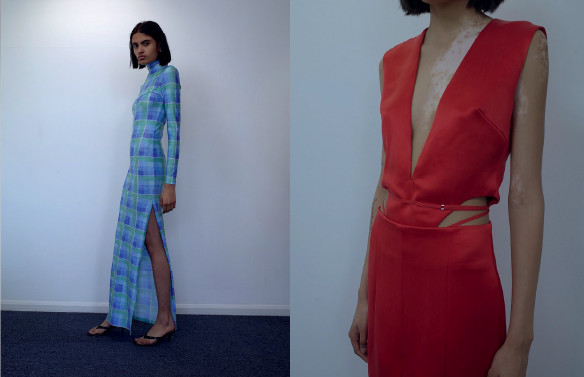FROM AN IRANIAN MILLINER CRAFTING FANTASTICAL HATS THAT RESEMBLE SCULPTURE TO A GENDER-FLUID HONG KONG LABEL CHALLENGING TRADITIONAL NOTIONS OF MASCULINITY, THE SEVEN EMERGING BRANDS FEATURED HERE SHARE ONE THING IN COMMON: FOUNDERS WITH ROOTS IN ASIA – AND BOLD IDEAS THAT THE WORLD SHOULD KNOW ABOUT. KENG YANG SHUEN REPORTS.



COMMISSION
Who by and where from: The New York-based trio of Huy Luong and Dylan Cao from Vietnam and Jin Kay from South Korea – all first-generation immigrants who met while studying at the Parsons School of Design and started the label in 2018. Why know it: Think of Commission as the founders’ love letter to their origins – or more specifically their mothers in the ’80s, when they were forging their respective careers in an East Asian landscape that was just starting to come into its own. This sweet story has translated into trendy yet polished interpretations of office-friendly wear that slyly winks at the working mum’s wardrobe from the era and motifs anyone who’s grown up in East Asia would find familiar. This season, for instance, florals just like the kind Luong’s and Cao’s grandmas would wear at home turn up on elegant draped midi dresses and pleated skirts. Design-minded women would meanwhile appreciate the brand’s sleek and languid staples that are spiked with just the right dose of thoughtful details such as a double row of belt loops on a slim, superbly cut pair of pants. Is it any wonder that the starmaking Net-a-porter enlisted the brand right from its first season as part of its emerging designer Vanguard programme and that it was shortlisted for this year’s LVMH Prize?

CARO CHIA
Who by and where from: The 25-year-old Caro Chia from Malaysia. Why know it: Having just launched earlier this year, this eponymous label might be the most obscure name on this list, but we’ve a feeling that it won’t stay under wraps for long. Chia’s Instagram account (@caro__chia), for instance, is catnip for design buffs with artfully taken visuals of her garments interspersed with that of abstract sculptures by the likes of the Dada-influenced Barbara Hepworth and Jean Arp. The latter and art in general are powerful influences on Chia, whose designs resemble fluid, architecturally cut experiments characterised by what she calls “uncertain” shapes. A corset top features extended panels with graphic, curved lines crafted from contrasting fabric. A diaphanous one-piece that she created during lockdown is more akin to a biomorphic Richard Serra installation than an evening-appropriate dress that has been ingeniously twisted and draped. That Chia’s designs come across as both cerebral and simmeringly sensual is no surprise – she interned at Supriya Lele (also featured in this story) and counts Helmut Lang as her fashion hero for the way he “interacted with fashion from an artist’s perspective”. For now, head to her website (www.carochia.com) for enquiries though we predict bigger things to come her way. (FYI: she’s also a sculptor and was behind all the ones depicted in the pictures here, alongside her clothes.)




BEHATI
Who by and where from: The Malaysian designer Kel Wen, who started the brand in 2018. Why know it: Last year, the label went viral within its home country for its colourful, hyper-oversized renditions of the baju melayu (a traditional ensemble for Malay men), inadvertently launching a debate over whether cultural dress can be considered fashion. Kuala Lumpur-born-and-based, Wen’s vision is born out of a desire to show that Malaysian culture and heritage can be inspiring and modern. Behati’s latest collection – available on its website www.behati.my – sees him fusing Western tailoring and suiting elements with local traditional attire. A polo shirt, for example, features the cekak musang collar – or raised stiff collar – of the baju melayu while a samfu top gets the runway treatment: aggressively upsized with strong, sculpted shoulders, channelling Demna Gvasalia-ism (Wen admits to admiring his work). Even the wooden clogs that used to be a common sight at home are given the Behati makeover with angular soles and slimmer, more sophisticated block heels. For all the talk its pieces and equally tongue-in-cheek campaigns have garnered, the brand counts some of Malaysia’s most stylish celebrities as well as young creatives as fans.






MARYAM KEYHANI
Who by and where from: Maryam Keyhani, an Iran-born milliner who’s been variously referred to as an artist and designer. Why know it: The most accurate way to describe Keyhani, who started the label two years ago, might just be a surrealist sculptor whose medium happens to be headpieces. Her fantastical, oversized creations evoke a certain rarefied (if eccentric) old-world grandeur that’s all but disappeared and makes one think of anything from the Mad Hatter in Alice in Wonderland to that supreme aesthete Marchesa Luisa Casati. Not formally trained in millinery, her extravagantly imaginative headgear might have more to do with her artistic background – the daughter of a painter, she took up sculpting before starting a now-defunct jewellery line. Never seen without a hat herself, Keyhani points out that what ultimately lies at the heart of her millinery – which debuts here this month at On Pedder – is the idea of playful fantasy as a form of escapism and protection. Can’t disagree with that.


SUPRIYA LELE
Who by and where from: The Midlands-raised, London-based British-Indian designer Supriya Lele who’s been blowing up steadily since her debut in 2017. Her latest accolades include being one of the eight finalists who shared this year’s LVMH Prize while Dua Lipa has taken a liking to her minimalist, sensuous pieces stocked at the likes of Ssense and Dover Street Market. Why know it: All signs have pointed to Lele’s guaranteed ascent from the start – she had showed under the influential Fashion East scheme (the non-profit, pro-emerging designer platform that’s launched the careers of everyone from Kim Jones to Simone Rocha) before putting on her first solo show last year. The brand’s allure lies in Lele’s intersectional approach to design. Imagine the throbbing yet understated sensuality of a ’90s Margiela number fused with subversive takes on traditional Indian dress. In her hands, Madras checks pulsate in highlighter hues while the dupatta (a shawl-like scarf) has been reimagined into the sheer, asymmetrical dress that’s become a signature piece. Yes, the latter might scandalise her elders, but it’s also exactly the kind of outfit progressive, body-confident women have been waiting for.

PENG TAI
Who by and where from: The Taiwan-born, Paris-based designer Peng Tai, who founded this eponymous womenswear label three years ago. Why know it: There’s slow, artisanal fashion and then there’s Peng Tai, whose romantic (if primordial) output is his way of celebrating the power of craft and nature. Take how he uses earthy materials and Chinese herbs such as astragalus and galla chinensis to stain his fabrics, which ensures that each piece is unique. Every one of his collections is governed by the ancient Chinese philosophy of the “five elements” – namely metal, wood, water, fire and earth. It could all plunge easily into hippie territory in the hands of lesser aesthetes, but the Peng Tai sensibility runs more towards the artfully rough-hewn. One could easily imagine dancers, artists, writers (Virginia Woolf comes to mind) inhabiting his ethereally distressed wares, which come packed with hints of wood nymphs, Edwardian dress, frayed hems and the like. Unsurprisingly, things are made the old-fashioned way in his Paris atelier – each craftsperson makes their assigned design from scratch; no assembly lines, thank you very much. Small wonder that his tightly curated group of stockists include only some of the most individualist stores globally, including Y Concept in Paris, Layers in London and Dover Street Market here.

PONDER.ER
Who by and where from: Designers Alex Po and Derek Cheng, who hail from Hong Kong and started this gender-fluid label last year. Why know it: Ponder.er brings a tender new voice to the menswear realm. “Liquifiying modern masculinity” is their tagline and the duo, who met while studying at Central Saint Martins, specialise in softening the male gaze. Traditional staples such as a polo shirt, for example, are crafted from a delicate custom lace knit while a classic men’s shirt is rendered anew as a tactile (and more romantic) number through smocking techniques – typically used only in womenswear. (The guys are particularly adept in textile manipulation – Po took a master’s in knitwear at the Royal College of Art and their latest collection is replete with textures inspired by objects found on the streets, such as discarded mattresses.) Growing up, both Po and Cheng encountered being labelled as too feminine or being asked to “man up” and the questions and psychological grappling that such experiences raised have been channelled into their designs. At the heart of the brand is a desire to counter ossified perspectives on what masculinity should look like and to expand its narrow parameters. Indeed Ponder.er is finding strength in softness – this collection marked its debut at Paris Men’s Fashion Week earlier this year and its customers comprise men and women alike. Nearest stockists include cult, directional boutiques such as Tokyo’s Wut and Shanghai’s Labelhood, though for now, you can head to Amazon Fashion.

previous article
next article























